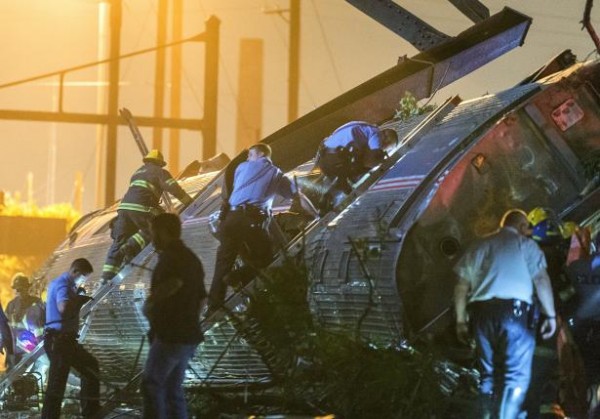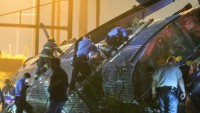Amtrak Train Derailment Update: Cause Determined? Death Toll Rises To Seven
| Althea Serad | | May 14, 2015 03:14 AM EDT |
(Photo : REUTERS: BRYAN WOOLSTON) Rescue workers climb into the wreckage of a derailed Amtrak train to search for victims in Philadelphia, Pennsylvania May 12, 2015.
The cause of the Amtrak train derailment that killed at least seven people and injured more than 200 others is now being investigated, and officials may have just come closer to determining what could have brought the disastrous event.
Speed was reportedly one possibility apparent to many.
Like Us on Facebook
According to an official with direct knowledge of the investigation, authorities are focusing on speed as the robable cause of the Amtrak crash, considering the angles of the wreckage and kind of damage to the cars. The recorder, or "black box," could also be crucial in learning the cause, said former NTSB official John Goglia.
Though authorities have kept mum on the cause of the derailment of Amtrak Northeast Regional Train 188 in Philadelphia on Tuesday night, Philadelphia Mayor Michael Nutter expressed his opinion on the train's engineer, albeit harsh.
"Clearly it was reckless in terms of the driving by the engineer. There's no way in the world he should have been going that fast into the curve," Nutter told CNN's "The Situation Room."
According to preliminary data, the speed of the train before the derailment exceeded 100 mph, which was more than twice the 50 mph speed limit at the curve it had been.
Meanwhile, NTSB board member Robert Sumwalt contradicted Nutter's comments, saying they were inflammatory, reported CNN.
"You're not going to hear the NTSB making comments like that. We want to get the facts before we start making judgments," said Sumwalt.
The engineer operating the train, identified to be Brandon Bostian, 32, from New York, applied full emergency brakes seconds before the fatal incident, Sumwalt said.
However, since the train was traveling at 106 miles per hour when Bostian applied the emergency brakes, the train slowed only slightly, according to federal authorities.
Apart from the emergency brakes, a system called "positive train control" could also have prevented the crash, Sumwalt said. Apparently, the commuter rail route where the Amtrak train left the tracks had not been worked with an advanced safety technology that could prevent high-speed derailments.
"Based on what we know right now," he told reporters at a news conference, "we feel that had such a system been installed on this section of track, this accident would not have occurred."
Reports said that the PTC system automatically slows or even halts trains moving too quickly or heading into a danger zone. Under the current law, the rail industry should have already adopted the technology by the end of the year.
Investigations on the cause of the Amtrak derailment have began, but initial examination of the train's data recorders confirmed that the train had traveled 106 miles per hour (171 km per hour) in a 50 mph (80 kph) zone, according to Huffington Post.
It is impossible for a train to reach the said speed if the PTC system had been governing the tracks, federal officials said. They added that Amtrak has already begun installing components of the system, but they are not yet functioning.
It is too early to determine whether speed alone caused the Amtrak train wreck, investigators said, adding that they will be examining other factors such as track conditions, throttle and brake settings, and alarms in the engineer's cab. Investigators are also looking into the footage from the forward-facing camera mounted on the train. They are also planning to interview the engineer and other crew members.
Amtrak officials have yet to comment on the incident.
TagsAmtrak train, Derailed Amtrak Train Safety Controls, Philadelphia Amtrak Crash, Philadelphia Train Crash, Philadelphia Amtrak Derails, Philadelphia Amtrak Derailment, Philadelphia Amtrak Crash Safety, Amtrak Positive Train Control, Philadelphia Positive Train Control, Amtrak Train Derailment Update
©2015 Chinatopix All rights reserved. Do not reproduce without permission
EDITOR'S PICKS
-

Did the Trump administration just announce plans for a trade war with ‘hostile’ China and Russia?
-

US Senate passes Taiwan travel bill slammed by China
-

As Yan Sihong’s family grieves, here are other Chinese students who went missing abroad. Some have never been found
-

Beijing blasts Western critics who ‘smear China’ with the term sharp power
-

China Envoy Seeks to Defuse Tensions With U.S. as a Trade War Brews
-

Singapore's Deputy PM Provides Bitcoin Vote of Confidence Amid China's Blanket Bans
-

China warns investors over risks in overseas virtual currency trading
-

Chinese government most trustworthy: survey
-

Kashima Antlers On Course For Back-To-Back Titles
MOST POPULAR
LATEST NEWS
Zhou Yongkang: China's Former Security Chief Sentenced to Life in Prison

China's former Chief of the Ministry of Public Security, Zhou Yongkang, has been given a life sentence after he was found guilty of abusing his office, bribery and deliberately ... Full Article
TRENDING STORY

China Pork Prices Expected to Stabilize As The Supplies Recover

Elephone P9000 Smartphone is now on Sale on Amazon India

There's a Big Chance Cliffhangers Won't Still Be Resolved When Grey's Anatomy Season 13 Returns

Supreme Court Ruled on Samsung vs Apple Dispute for Patent Infringement

Microsoft Surface Pro 5 Rumors and Release Date: What is the Latest?











